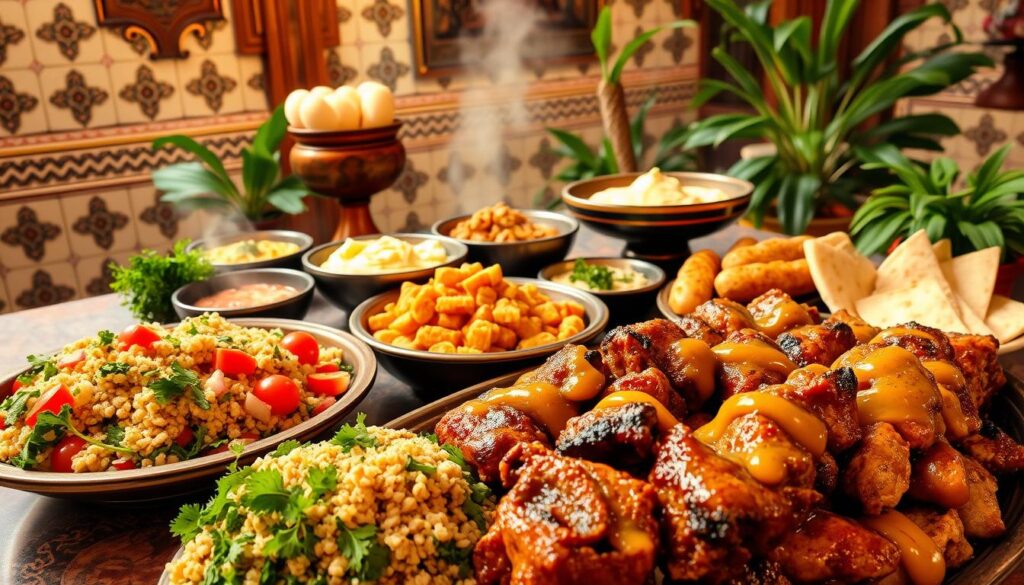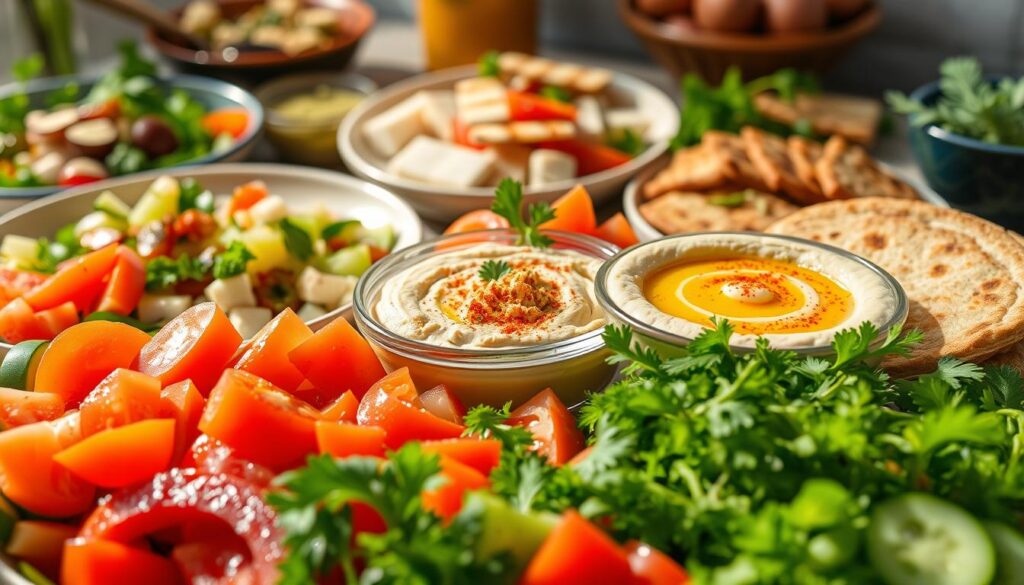Exploring Lebanon’s food scene is like stepping into a world of flavors and traditions. The country’s location at the Mediterranean’s crossroads adds to its rich culinary heritage. Lebanese dishes are a mix of authentic lebanese cuisine and Middle Eastern flavors, perfect for food lovers.
Every ingredient in Lebanese cooking is chosen with care. This ensures dishes are both healthy and tasty. Whether you’re a seasoned foodie or new to international cuisine, Lebanese food is a journey of discovery. It offers a mix of diverse flavors and healthy ingredients.
Introduction to Lebanese Food dishes
Lebanese recipes blend authentic lebanese cuisine with Middle Eastern flavors. This makes them a great way to explore Lebanon’s food culture. As you explore easy Lebanese recipes, you’ll find a world of tastes and traditions that will keep you coming back for more.
Key Takeaways
- Lebanese cuisine offers a unique blend of authentic lebanese cuisine and Middle Eastern food
- Authentic lebanese cuisine are made with fresh and healthy ingredients
- Lebanese food is a great way to experience the country’s rich gastronomic heritage
- Lebanese cuisine is known for its diverse flavors and aromas
- Lebanese recipes are a must-try for any food enthusiast
Table of Contents
The Rich Heritage of Lebanese Gastronomy
Exploring Lebanese cuisine reveals a deep cultural heritage. It’s tied to the country’s history and family traditions. Lebanese culture values warm hospitality, and food is key to bringing people together. Over centuries, Lebanese dishes have been shaped by Mediterranean flavors and ingredients.
At the core of Lebanese cuisine are family recipes passed down through generations. These recipes are treasured secrets, with each family adding their own twist. As you explore, you’ll see dishes made with love, using fresh ingredients and traditional methods.
To truly appreciate Lebanese gastronomy, understanding its cultural significance is key. Here are a few important points:
- Food symbolizes hospitality and generosity in Lebanese culture
- Meals are chances to bond and strengthen family ties
- Authentic lebanese cuisine use fresh, local ingredients whenever possible
Embracing Lebanese gastronomy lets you appreciate the country’s cuisine history and its people. Whether cooking traditional dishes or enjoying a meal with loved ones, you’ll feel the warmth and generosity of Lebanese culture.
Essential Ingredients in Authentic Lebanese Cuisine
Exploring Lebanese cuisine reveals its secret: fresh, healthy ingredients. The Mediterranean diet, which Lebanese cuisine follows, focuses on whole foods, herbs, and spices. This approach makes dishes both tasty and good for you.
At the heart of Lebanese cuisine are fresh veggies, fruits, whole grains, and lean proteins. Lebanese spices add depth and warmth to dishes. Healthy ingredients like olive oil, garlic, and lemon juice boost flavor and nutrition. The Mediterranean diet shows how Lebanese food can be both delicious and healthy.
Some key ingredients in Lebanese cuisine are:
- Fresh vegetables like eggplants, bell peppers, and tomatoes
- Herbs and spices like cumin, coriander, and sumac
- Whole grains like bulgur and rice
- Lean proteins like chicken, fish, and lamb
Using these ingredients in your cooking lets you truly experience Lebanese cuisine. It also brings the health benefits of the Mediterranean diet. Lebanese cuisine is a flavorful way to live healthier with its focus on fresh ingredients and traditional spices.
Traditional Lebanese Cooking Methods
To master traditional Lebanese cooking, you need to know the different methods. These methods mix old techniques with new ideas, showing Lebanese cooks’ creativity. By using these methods, you can taste Lebanon’s true flavors and connect with its food heritage.
Lebanese cooking often uses grilling over charcoal, slow cooking in clay pots, and preserving food. These ways let you enjoy seasonal foods all year. Grilling techniques are key, making meats and veggies taste smoky.
Some important Lebanese cooking methods are:
- Grilling over charcoal for a smoky flavor
- Slow cooking in clay pots to tenderize ingredients and meld flavors
- Preserving vegetables and meats through pickling and curing
Using these methods in your cooking can make delicious Lebanese dishes. Whether you’re slow cooking meats or grilling for smokiness, you’ll taste Lebanon’s true flavors. This way, you connect with Lebanon’s cultural traditions.
Signature Lebanese Spice Blends
Exploring Lebanese cuisine reveals a secret: its unique flavors come from special Lebanese spices and spice blends. These blends change by region and taste, showing the country’s rich culture.
Middle Eastern flavors like cumin, coriander, and sumac are key in Lebanese cooking. These spices are mixed in certain ways to make special blends. For instance, a mix of cumin, coriander, and cinnamon is used for meats and stews.
Some well-known Lebanese spice blends are:
- Ras el hanout, a mix of spices that translates to “head of the shop” and is used to add flavor to a variety of dishes
- Shawarma spice, a blend of spices used to season meats for the popular street food
- Kebsa spice, a mix of spices used to flavor rice and meat dishes
Trying out different Lebanese spices and spice blends can help you make dishes that truly capture Middle Eastern flavors.
Popular Lebanese food : Mezze Dishes
Mezze dishes are key in Lebanese cuisine. They’re small, shareable plates meant for family and friends. Sharing food brings warmth and hospitality, showing Lebanese culture’s heart.
These dishes offer a variety of tastes and textures. You can try cold mezze like tabbouleh and hummus, or hot mezze like falafel and grilled halloumi. Each dish shows Lebanon’s rich culinary heritage. Some favorites include:
- Tabbouleh: a fresh salad with parsley, tomatoes, and bulgur
- Hummus: a creamy dip with chickpeas, tahini, and lemon
- Falafel: crispy chickpea patties full of flavor
- Grilled halloumi: a cheese that’s great for grilling with mezze
Sharing food is central to mezze. It’s more than eating; it’s about connecting and enjoying life’s simple moments. Trying traditional or new mezze dishes, it’s all about sharing and coming together.
Embracing mezze lets you dive into Lebanese cuisine’s variety and hospitality. With its rich flavors, lively culture, and focus on sharing, mezze offers a unique and delightful dining experience.
Main Course Delicacies in Lebanese Cooking
Exploring Lebanese cuisine reveals a wide range of main courses. These dishes highlight the country’s culinary skills. You’ll find everything from grilled meats and stews to vegetarian options and seafood. Each dish is a taste of Lebanon’s rich flavors and traditions.
Lebanese main courses are known for their bold tastes and generous portions. Dishes like shawarma, kebabs, and machboos are beloved. They offer a peek into Lebanon’s culinary past. Whether you prefer classic or adventurous dishes, Lebanese cuisine has it all.
Some popular authentic lebanese cuisine include:
- Grilled lamb chops with a side of roasted vegetables
- Chicken shawarma wraps with tahini sauce and pickles
- Vegetarian stuffed bell peppers with rice, herbs, and spices

Each Lebanese main course reflects the country’s history and culture. Lebanese cuisine is a mix of Mediterranean and Middle Eastern flavors. It’s perfect for anyone looking to try something new. So, why not start your culinary adventure with Lebanese main courses?
Lebanese Bread and Pastries
Exploring Lebanese cuisine, you’ll find Lebanese bread and pastries are key. They have a rich history and cultural importance. These treats have been made for centuries, using baking techniques passed down through generations.
There are many types of traditional pastries and bread, like pita, ka’ak, and baklava. Each has its own taste and texture. Learning to make Lebanese bread and pastries connects you to the traditions and people of this cuisine.
Some favorite Lebanese bread and pastries include:
- Pita bread: a classic flatbread perfect for scooping up dips and stews
- Baklava: a sweet pastry filled with nuts and honey
- Ka’ak: a crispy, sesame-topped bread often served with cheese or za’atar
Learning baking techniques and trying new ingredients lets you make your own Lebanese bread and pastries. They’re great for sharing with loved ones. Whether you’re experienced or new to baking, Lebanese bread and pastries offer something for everyone.
Lebanese Desserts and Sweet Treats
Exploring Lebanese cuisine reveals a variety of tasty Lebanese desserts and sweet treats. You’ll find traditional sweets like ma’amoul and baklava, alongside modern creations. These desserts are sweet, with flavors of nuts, honey, and rose water.
Popular Middle Eastern pastries include knafeh and zalabia. Knafeh is made with shredded phyllo dough and cheese. Zalabia is a fried doughnut soaked in syrup. These traditional sweets are enjoyed at special events and are a big part of Lebanese culture.

Trying to make these desserts at home is a great way to enjoy Lebanese sweets. With some practice, you can impress your loved ones with delicious Lebanese desserts. Whether you prefer traditional sweets or modern ones, Middle Eastern pastries and Lebanese desserts are irresistible.
Some other beloved Lebanese desserts include:
- Ma’amoul: a shortbread-like cookie filled with dates or nuts
- Baklava: a layered pastry made with phyllo dough, nuts, and honey
- Knafeh: a dessert made with shredded phyllo dough and cheese
These are just a few examples of the many delicious traditional sweets and Middle Eastern pastries found in Lebanese cuisine.
Beverages and Accompaniments
Exploring Lebanese cuisine reveals the importance of traditional drinks in their culture. You must try the famous Lebanese coffee. It’s a key part of their welcoming tradition, bringing people together.
Herbal teas are also a big part of Lebanese life. They offer a calm, refreshing choice to coffee. Favorites include mint, chamomile, and lemon balm, which taste great and are good for you.
Lebanon offers a wide range of drinks. From Lebanese coffee to herbal teas, there’s something for everyone. Here are a few popular ones to try:
- Lebanese coffee: a strong, rich coffee made from finely ground coffee beans
- Herbal teas: a variety of teas made from herbs like mint, chamomile, and lemon balm
- Traditional beverages: a range of drinks made from natural ingredients like fruits, flowers, and herbs
In Lebanese culture, drinks are key to social gatherings and welcoming guests. Trying these drinks lets you join in on their traditions. It’s a way to make memories and connect with loved ones.
Health Benefits of Lebanese Food
Lebanese cuisine focuses on fresh veggies, fruits, whole grains, and lean proteins. It’s a great example of healthy Lebanese food. By following the Mediterranean diet, you can enjoy many Mediterranean diet benefits. These include better heart health and weight management.
The nutritional value of Lebanese dishes comes from using whole, unprocessed foods and healthy cooking. This mix of nutrients, fiber, and antioxidants is key for staying healthy and feeling good.

- Reduced risk of chronic diseases, such as heart disease and diabetes
- Improved digestion and bowel health
- Boosted immune system
By following Lebanese cuisine, you can boost your health and well-being. You’ll lower the risk of chronic diseases and enjoy a better quality of life.
Conclusion: Embracing the Legacy of Lebanese Cuisine
When you enjoy the varied tastes and deep traditions of Lebanese cuisine, you’re not just eating. You’re experiencing a part of Lebanon’s cultural heritage and food traditions that have lasted for ages. Every dish, ingredient, and cooking method shares a story of Lebanon’s history and today.
By diving into the legacy of Lebanese cuisine, you’re not just having tasty meals. You’re joining a global conversation that goes beyond borders and time. Whether you’re Lebanese or just love trying new foods, this tradition welcomes you with open arms. It connects you to a lively and rich heritage.
Keep exploring the world of food, especially Lebanese flavors. This will not only feed your body but also broaden your view of the world. Every bite is a step towards understanding and appreciating the diversity of global cuisines.
FAQ
What are the key ingredients that make authentic lebanese cuisine so unique and flavorful?
Lebanese food is all about fresh veggies, fruits, whole grains, and lean meats. It’s a true Mediterranean diet. The secret is in the ingredients, chosen for their freshness and nutritional value.
What are the traditional cooking methods used in Lebanese cuisine?
Lebanese cooking is all about grilling, slow cooking in clay pots, and preserving food. These methods show the creativity and resourcefulness of Lebanese cooks. They add special flavors and textures to the dishes.
What are the signature spice blends used in Lebanese cuisine?
Lebanese food is known for its unique spice mixes. These blends can change based on region and taste. They often include cumin, coriander, sumac, and pomegranate molasses. Exploring these spices can help you make dishes that truly taste like Lebanon.
What is the tradition of mezze in Lebanese dining?
Mezze is a big part of Lebanese dining. It’s a variety of small dishes shared with family and friends. From tabbouleh and hummus to falafel and grilled halloumi, each dish shows the country’s rich food culture. Sharing mezze is about more than just eating; it’s about connecting and enjoying life’s simple moments.
What are some of the health benefits of Lebanese cuisine?
Lebanese food is great for your health, thanks to its focus on fresh veggies, fruits, whole grains, and lean proteins. It follows the Mediterranean diet’s principles. Lebanese dishes are full of nutrients, fiber, and antioxidants, helping to prevent chronic diseases and improve overall health.
There are no reviews yet. Be the first one to write one.

